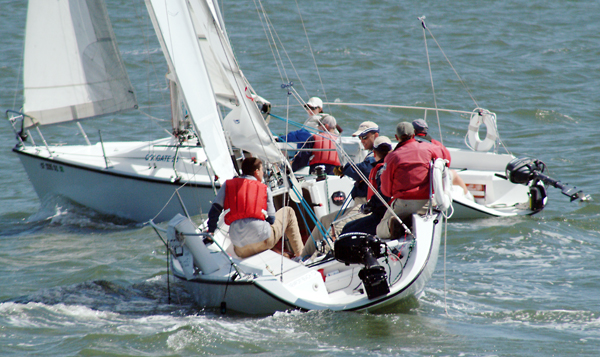
race report
| home | contact us | movies | galleries | recent stories | archived stories | store |

 The Army team hunts the Navy. ©2010 norcalsailing.com |
|
American Armed Forces Regatta May 16, 2010 "The Air Force came out of nowhere like a stealth bomber." But they weren't flying a training mission, they were sailboat racing, in the second American Armed Forces Regatta, organized by Club Nautique in Alameda on Armed Forces Day to show appreciation for our servicemen and women.
Each branch of the service is invited to field a team to compete in one design racing in Colgate 26s. These daysailers designed specifically for sailing instruction, and were ideal for this regatta. Each boat has a Club Nautique instructor aboard, who trained the crews in the morning.They remained onboard as safety officers, but were required to stay behind the traveler and not touch anything except as needed for safety. Besides the coaches, the Navy had two crew aboard, while the others each had three. Some of the crew on the Coast Guard and Air Force teams had sailed before, and those boats did the best. Except for Air Force, each boat had one woman aboard, and those three women took the helm. The Marine Corps team couldn't make it this year due to troop deployments.
Club Nautique is situated on the west side of Alameda, on Ballena Isle, so racing took place on the windy South Bay, not the protected Estuary. A #1 pennant flew from Jeff Zarwell's RegattaPro Race Committee boat, signaling a single reef. A #2 pennant would signal a double reef. Because a strong northwesterly had already filled in at the 1400 start of the first race, Club Nautique's Sailing School Director, Dave Scott, called the mandatory single reef from the spectator boat, which he was skippering. Dave considered a second reef after the Race 2, but the competitors talked him out of it.
The course was a windward-reach-leeward triangle, twice around, with the windward mark about .75 mile distant, making for a 3-4 mile course. The goal was to have three races in three hours, with each race lasting less than an hour. Given the wind conditions, this goal was easy to achieve.
SN Lindsey Schmid, who drove the victorious Coast Guard boat, said she had last sailed at age 12 in a 14-ft dinghy. "And I was really tense the whole time. On one port-starboard situation, the Air Force came out of nowhere like a stealth bomber." The Air Force finished the regatta in second place, as they did each race. Navy finished third, and Army fourth.
This was the second Armed Forces Cup, with a rule in place that no one who sailed last year could repeat. Last year, the Coast Guard had a ringer onboard, who had raced for the Coast Guard Academy team. The Marine Corps came in second - and they were thrilled because none of them had ever sailed before.
On this same racing area in the South Bay, Ballena Bay YC runs Friday night beer can races every other week. Two of the Club Nautique Colgates compete in them regularly, with 1.5 oz. Club Nautique spinnakers. General Manager Jim Hancock says he'd like to build the fleet of C26s up to ten.
|
||||||||